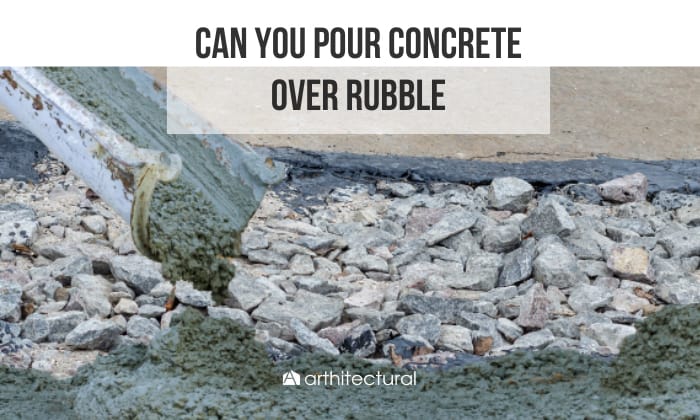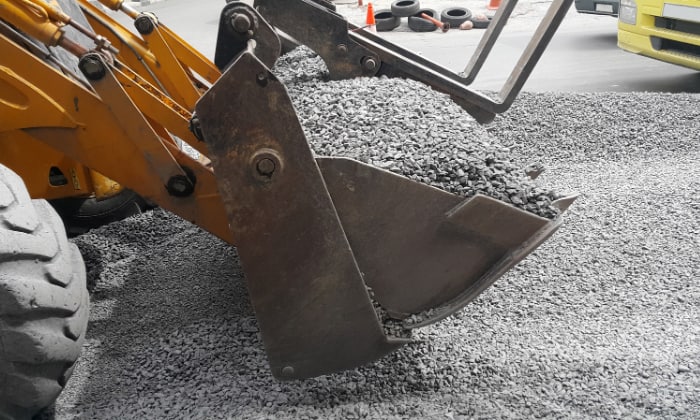Can You Pour Concrete Over Rubble? Is It Safe?
In construction projects, finding efficient and cost-effective solutions is crucial. If you encounter a cluttered area filled with rubble, you may question, “Can you pour concrete over rubble?” Concrete is a versatile option for construction, ... Read more The post Can You Pour Concrete Over Rubble? Is It Safe? appeared first on Arthitectural.


In construction projects, finding efficient and cost-effective solutions is crucial. If you encounter a cluttered area filled with rubble, you may question, “Can you pour concrete over rubble?”
Concrete is a versatile option for construction, allowing it to be poured over rubble. Read on to know about concrete running over rubble and rubble characteristics. You should also learn to use rubble as a subgrade for concrete foundations, as well as its pros and cons.
Rubble and Its Characteristics:

Rubble refers to fragmented or loose pieces of masonry, concrete, brick, or other construction materials that result from demolition, excavation, or natural disasters. The characteristics of rubble vary widely, including particle size, composition, and structural integrity.
Large debris, such as concrete chunks, may require additional considerations compared to smaller fragments like gravel or crushed stones.
Using Rubble as Subgrade for Concrete Foundations:

One of the advantages of concrete is its versatility. You can pour it over anything, such as rubble, asphalt, or soil. Using broken concrete as a sturdy sub-base can be a cost-effective alternative to traditional subgrade materials like gravel or crushed stone.
The rubble can provide stability, reduce settlement, and potentially contribute to recycling by repurposing existing materials.
However, proper preparation and considerations are necessary to ensure a durable and stable foundation.
- Before constructing your foundation, it’s essential to determine your soil type and assess its strength to support the load placed on the foundation. Ensure that the soil is free of organic matter, as decomposing organic matter can cause soil to become loose, potentially weakening the foundation.
- Then, it is required to break rubble into finer pieces using a jackhammer. In other words, you should pour concrete over crushed concrete only.
- Next, level ground before pouring concrete to ensure the foundation is solid and stable.
- Pouring a concrete slab into sections allows for better control and reduces the risk of cracking.
- During construction, the workers should carefully pour the cement mixture to create a solid and level base, ensuring that the rubble foundation pour is even and stable on top of the concrete.
Pros and Cons of Using a Rubble Foundation

A rubble foundation offers advantages and disadvantages compared to concrete, making it a viable option for certain construction projects. Here is a breakdown of its pros and cons:
- Cost-Effective: Rubble foundation is generally cheaper than concrete.
- Minimal Finishing Required: Unlike concrete, rubble foundations do not require extensive finishing work, reducing overall construction time and costs.
- High Safety Margin: The foundation provides a large margin of safety, ensuring stability and durability for the structure. They are also suitable for supporting heavy loads.
- Environmentally Friendly: Using natural stones makes the foundation ecologically clean and sustainable. Furthemore, reusing concrete slabs helps minimize waste.
- Resistance to Decay: Rubble foundations are immune to mold, mildew, decomposition, and corrosion, contributing to longevity.
- Water Resistance: The foundation exhibits low hydrophobicity and excellent water resistance, safeguarding against water damage.
- Temperature Resistant: Rubble foundations can withstand temperature changes without compromising their integrity.
- Time-Consuming: Building a rubble foundation requires substantial time spent on adjusting the stone fragments to the desired size, which can slow down the construction process.
- Irregular Shapes: The difficulty lies in performing masonry with stones of non-standard shapes, which demands skilled craftsmanship and precision.
- Heavy Weight: Rubble foundations can be significantly heavier than other options, necessitating suitable load-bearing structures.
- Unsuitable for Multi-Storey Buildings: Due to the weight and structural limitations, rubble foundations are unsuitable for constructing multi-story buildings.
- Repairs Challenges: The irregular shape of the stone fragments poses difficulties in repairs, making maintenance more intricate.
By analyzing these strengths and weaknesses, you can make an informed decision regarding the suitability and implementation of a rubble foundation for your specific construction project.
FAQs
Can we pour concrete on wet ground?
Pouring concrete on soft ground is not recommended. That’s why we need a layer called the sub-base that is robust enough. However, if you have to pour concrete on soft and wet soil, make sure the soil is not saturated with water. If the soil is just damp, then it might be okay.
Is it possible to make concrete without a gravel base?
For your information, making concrete requires gravel, cement, and sand. Therefore, you need to have all these ingredients and use the right ratio to make concrete.
How to repurpose old concrete?
If you have old concrete lying around, recycle them to create aggregate, then use them as a subbase.
Conclusion
As the construction industry progresses towards sustainable and efficient practices, pouring concrete over rubble is a promising technique to repurpose waste material and minimize environmental impact.
So, can you pour concrete over rubble? The answer is yes. However, to ensure the stability and durability of the foundation, careful consideration of the rubble’s characteristics, thorough preparation, and compaction are imperative.
Builders can make informed decisions for successful, eco-friendly projects by embracing innovative approaches like pouring concrete over rubble, balancing pros and cons, and considering essential factors.
The post Can You Pour Concrete Over Rubble? Is It Safe? appeared first on Arthitectural.
